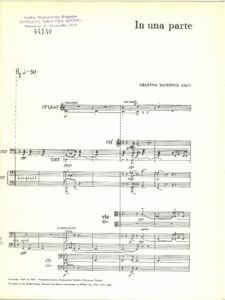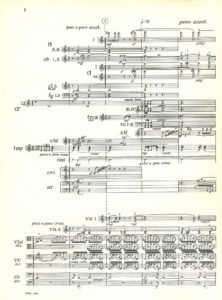In 1967 Grażyna Bacewicz received a commission from Cuba to write an instrumental piece to be performed in Havana in 1968, at the Contemporary Music Festival. The commission was accompanied by an invitation to a concert. The composer became very enthusiastic about the journey, as is evidenced by letters to her brother Witold, who was living in the United States at the same. However, the journey did not happen. The premiere, without the composer, took place on 2 October 1968 in Havana, during the festival. The National Orchestra of Cuba was conducted by Manuel Duchesne Cuzán. The plan to bring the Cuban orchestra to Poland was not put into practice either. The first Polish performance of the work took place on 11 October 1968 in Szczecin. The Orchestra of the Szczecin Philharmonic was conducted by Renard Czajkowski. The composer’s correspondence with Witold Rowicki suggests that there were plans to perform the work at the 1968 Warsaw Autumn, but the following passage from Bacewicz’s letter to the conductor clearly shows that she distanced herself from the project: “The third option – to show In una parte at the festival – would not make me happy.” According to the composer, a piece more worthy of being presented at the festival was her Concerto for Two Pianos and Orchestra.
Nearly a decade had to pass before In una parte, Grażyna Bacewicz’s last orchestral work, appeared at the Warsaw festival. On 21 September 1977 it was performed by the Leningrad Philharmonic Orchestra conducted by Alexander Dmitrev. There is an interesting review by Ludwik Erhardt, published in issue 23 of Ruch Muzyczny in 1977. While praising the musicians for their rendition splendidly highlighting personal features of the composer’s style, the author nevertheless notes that in a period of a sudden surge of romantic rapture, this style seems quite distant – because of both its classical discipline and it emotional restraint. The review was written from the perspective of a reality which, especially in Polish music, meant a return to some romantic expressive categories, or a new, more contemplative approach to musical time – as Leszek Polony argued during the National Musicological Conference in Kraków in 1983.
From the perspective of the twenty-first century, when the “time of the avant-garde” has passed, as has the time of “romantic rapture”, we can look at Grażyna Bacewicz’s last orchestral piece differently. The degree of dissociation of the material is more advanced than in Contradizione, composed a year earlier. The neo-bruitist aesthetics of the piece, affirming the “emancipated sound”, seems to invalidate the need to establish rules ordering the passage of sound molecules constantly changing their form. And yet such an order does exist. The piece has several phases with a clear dramatic profile, climaxes and expressive turning points marking a release of tension and a change in the sound aura. Sonic “barbarism” predominates, although more subdued sequences appear as well. A characteristic feature of the work is a mixture-like quality of the sound, which, combined with isolated motifs and articulation diversity, creates an impression of sonic abstraction. What is characteristic is the very beginning of the piece. It grows out of a quiet (con sordino), low note of the cellos, on top of which comes a quiet tremolo of the timpani, “tapping” on the sound box of the harp, and sound of the tam-tam. Soon, however, other instruments come in with their ephemeral figures, tremolos and glissandos. With a constant grow of dynamics, there emerge in the strings reminiscence-like ostinatos as well as interval scales which disappear in the mass of other sounds, like glissandos on the piano strings, various scale runs, isolated chords struck sforzato. The first climax ends with a long tam-tam sound. The instrument which in this sonic panopticon acts as the “only righteous” instrument is usually celesta with its gentle sound. The instrument appears in the following and several other sequences.
What is striking in the piece is the treatment of the strings, which cannot develop their cantilena. There are frequent instances of playing sul ponticello, sul tasto, col legno, a punta d`arco and glissando spiccato. Many of these ways of playing occur “polyphonically” in one fragment (for example, in no. 3). Other instruments, like flutes and oboes, cannot develop their melodic assets either. And yet in this changing soundscape, stretched between a sonoristic tutti and fragments with more arabesque outlines, there is some evidence of a connection with the past, evidence in the form of slightly camouflaged self-quotations. Number 6 features a literal quotation from Divertimento presented by the violins in motifs composed of two tritones reached by way of a glissando: from A5 sharp and from D5 sharp (third bar after number 3 in the Divertimento). In number 16 we can hear the “signature” known from many of the composer’s pieces. It’s the Intermezzo theme from Partita, second movement (Andantino melancolico) of the Trio for oboe, harp and percussion, second movement (Andante) of the Concerto for Viola and Orchestra, or the beginning of Act 2 of the ballet Desire. In In una parte the theme is presented in minor ninths by flutes, oboes, B flat clarinets and E flat clarinet, complemented by notes which make up a nearly full twelve-note field.
In una parte is, perforce, the composer’s sound testament, as it were. The piece can be treated as a sound reverse of the delicate Pensieri notturni or as the crowning achievement of the “vitalist” strand, which began – in its “sonoristic” form” – with Music for Strings, Trumpet and Percussion. Is it also a reflection of the common mood in the late 1960s? After all, “music does not express any normal, everyday feelings, it just expresses itself and its own emotions,” as the composer claimed.
- In una parte, PWM score, p. 1
- In una parte, PWM score, p. 2

